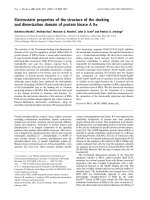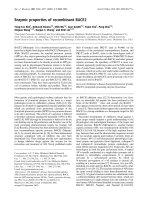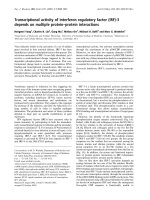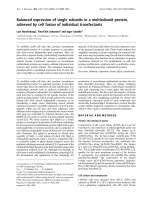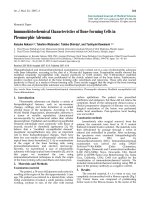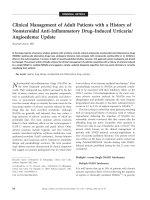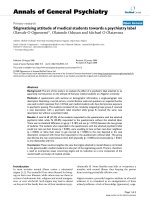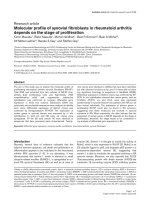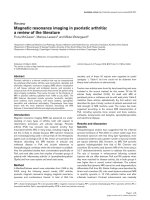Báo cáo y học: "Immunomodulatory properties of mesenchymal stem cells: a review based on an interdisciplinary meeting held at the Kennedy Institute" potx
Bạn đang xem bản rút gọn của tài liệu. Xem và tải ngay bản đầy đủ của tài liệu tại đây (193.84 KB, 10 trang )
Page 1 of 10
(page number not for citation purposes)
Available online />Abstract
Multipotent mesenchymal stromal cells isolated from bone marrow
and other sites are currently being studied to determine their
potential role in the pathogenesis and/or management of auto-
immune diseases. In vitro studies have shown that they exhibit a
dose-dependent antiproliferative effect on T and B lymphocytes,
dendritic cells, natural killer cells and various B cell tumour lines -
an effect that is both cell contact and soluble factor dependent.
Animal models of autoimmune disease treated with multipotent
mesenchymal stromal cells have mostly exhibited a positive clinical
response, as have a limited number of patients suffering from acute
graft versus host disease. This review summarizes the findings of a
1-day meeting devoted to the subject with the aim of coordinating
efforts.
Introduction
Although mesenchymal stem cells (MSCs) are most readily
recognized in the musculoskeletal system as potential
orchestrators of bone and cartilage repair, it has become
apparent in recent years that they may also have profound
immunomodulatory effects. Around 70 people participated in
this 1-day meeting at the Kennedy Institute for Rheumatology,
London, on 31 October 2005, to explore the latter aspect of
MSC biology in relationship to autoimmune diseases (ADs).
The aim was to bring together workers in the fields of MSC
biology and AD in order to define areas of potential synergy
and interdisciplinary collaboration. As pointed out by the
director of the institute, Marc Feldmann, following the rapidly
growing activity in the past few years in defining stem cell
participation in autoimmune mechanisms and in the use of
adult stem cells to treat ADs, a focus on the MSC has
emerged.
Such cellular therapy is already in an exploratory phase for
treating severe acute graft versus host disease (GvHD) [1],
which bears many similarities to some severe inflammatory
ADs. The mechanisms for such positive therapeutic effects
Meeting report
Immunomodulatory properties of mesenchymal stem cells: a
review based on an interdisciplinary meeting held at the
Kennedy Institute of Rheumatology Division, London, UK, 31
October 2005
Alan Tyndall
1
, Ulrich A Walker
1
, Andrew Cope
2
, Francesco Dazzi
3
, Cosimo De Bari
2
, Willem
Fibbe
4
, Serena Guiducci
5
, Simon Jones
3
, Christian Jorgensen
6
, Katarina Le Blanc
7
, Frank Luyten
8
,
Dennis McGonagle
9
, Ivan Martin
1
, Chiara Bocelli-Tyndall
1
, Giuseppina Pennesi
10
, Vito Pistoia
11
,
Constantino Pitzalis
2
, Antonio Uccelli
12
, Nico Wulffraat
13
and Marc Feldmann
2
1
Rheumatology, University Hospital Basel, Felix Platter Spital, Burgfelderstrasse 101, Basel, CH-4012, Switzerland
2
Medicine, DIIID, Rheumatology, King's College London, Strand, London, WC2R 2LS, UK
3
Stem Cell Biology, Kennedy Institute of Rheumatology Division, ARC Building, 1 Aspenlea Road, London, W6 8LH, UK
4
Immunohematology and Blood Transfusion, Leiden University Medical Center, Albinusdreef 2, Building 1, E3-Q, Leiden, 2300 RC, The Netherlands
5
Internal Medicine, Division of Rheumatology, University of Florence, Viale Morgagni, 85, Florence, I-50134, Italy
6
Service d'Immuno-Rhumatologie, Lapeyronie University Hospital, 371, av. du Doyen Gaston Giraud, Montpellier, F - 34295, France
7
Division of Clinical Immunology, Karolinska Institute, CMB, Box 285, Stockholm, SE-171 77, Sweden
8
Rheumatology Section, Leuven University Medical Centre, Herestraat 49, bus 813, Leuven, B - 3000, Belgium
9
Molecular Medicine Unit, Rheumatology, University of Leeds, Woodhouse Lane, Leeds, LS2 9JT, UK
10
Neuroimmunologia, University of Genova, Via L.B. Alberti, 4, Genova, I-16132, Italy
11
Laboratorio Scientifico di Oncologia, G.Gaslini Scientific Institute, Largo Gerolamo Gaslini, 5, Genova, I-16147, Italy
12
Department di Neuroscienze, University of Genova, Via L.B. Alberti, 4, Genova, I-16132, Italy
13
Department of Pediatric Immunolgy, University Medical Center Utrecht, Room KC03.063.0, Utrecht, NL-3508 AB, The Netherlands
Correspondence: Alan Tyndall,
Published: 29 January 2007 Arthritis Research & Therapy 2007, 9:301 (doi:10.1186/ar2103)
This article is online at />© 2007 BioMed Central Ltd
AD = autoimmune disease; BM = bone marrow; CTL = cytotoxic T lymphocyte; DC = dendritic cell; GvHD = graft versus host disease; IDO =
indoleamine 2′,3′-dioxygenase; IFN = interferon; IL = interleukin; MLR = mixed lymphocyte reaction; MSC = mesenchymal stem cell (multipotent
mesenchymal stromal cell); NK = natural killer; PBMC = peripheral blood mononuclear cell; PG = prostaglandin; RA = rheumatoid arthritis; SSc =
systemic sclerosis; TNF = tumour necrosis factor.
Page 2 of 10
(page number not for citation purposes)
Arthritis Research & Therapy Vol 9 No 1 Tyndall et al.
remain partly obscure, but the antiproliferative properties
exerted by MSCs on other cells is an important component
[2]. In addition, MSCs have been shown to exhibit tissue
protective and regenerative properties beyond immuno-
suppression, making them attractive therapeutic agents in
complex AD in which an admix of inflammatory and scarring
tissue damage is often present.
On the other hand, MSCs may also actively participate in
initiating AD [3], they have the potential to favour spread of
melanoma metastases [4] and, although mostly immune
privileged, they may under certain conditions also be subject
to immune rejection [5]. Thus, their role in treatment of ADs
must be assessed carefully.
Definition of a MSC
Although a true mesenchymal stem cell undoubtedly exists,
the commonly used terminology for various stroma-derived
progenitor cells, ‘MSC’, is scientifically inaccurate because a
true stem cell property has not been demonstrated. A true
stem cell, when dividing, gives rise to one daughter cell that
retains its full stem property, whereas the second daughter
progenitor cell has the potential, on proliferation and
differentiation, to replenish a complete pleiomorphic tissue
compartment. The best studied example is the haemato-
poietic stem cell. Also, the difference between embryonic and
adult (postnatal) somatic stem cells should be emphasized.
The International Society of Cellular Therapy recently
reported a consensus statement on the nomenclature and
definition of these progenitor cells [6]. Better termed a
‘multipotent mesenchymal stromal cell’, such a cell should be
plastic adherent (1-5 days), have fibroblast-like morphology,
bear at least the stromal markers CD73 and CD105, and be
negative for the haematopoietic markers CD14, CD34 and
CD45. Although opinions differ [7], the commonly agreed
markers are highlighted in bold in Table 1. In addition, a
trilineage potential for osteogenic, adipogenic and
chondrogenic differentiation should be demonstrable
(Figure 1). Chondrogenic differentiation is a tedious
procedure to perform. However, cell populations satisfying
these criteria are likely to still be heterogeneous. For practical
purposes, the multipotent mesenchymal stromal cell is
abbreviated to MSC in the subsequent text.
During the past few years various phenotypic descriptions of
MSCs in mouse and humans have been employed, which are
partly summarized in Table 1. This has led to some confusion
because the original monoclonal antibodies used by early
workers have since been shown to be directed to epitopes
on known CD antigens, for example SH3 and SH4 bind to
epitopes on CD73 [8] and SH2 to CD105 (also called
endoglin).
An extensive and referenced summary of MSC phenotypic
nomenclature is presented in Table 2.
Origin and sources of MSCs
MSCs were originally described in bone marrow (BM) [9],
where they were also termed ‘marrow stromal cells’. How-
ever, it has now became clear that similar but heterogeneous
populations of progenitor cells are also present in many other
tissues. MSCs can be isolated from periosteum [7,10],
muscle [11,12], synovium [13], synovial fluid [14], liver and
blood [15], cord blood [16] and fat [17], among others. The
source of MSCs has an influence on phenotype and
functional properties.
Cosimo De Bari reported that human MSCs from periosteum
have greater capacity to form bone in vivo than do human
MSCs from synovial membranes [7]. Simon Jones and
Christian Jorgensen showed that synovia-derived MSCs also
differ from their BM counterparts in their gene expression
profiles, with activin A being more highly expressed in BM-
MSCs [18]. Katarina Le Blanc pointed out that MSCs differ
between foetal and adult tissues, as indicated by the
differential expression of genes related to tissue
development, cell cycle promotion, chromatin regulation,
DNA repair and immunological antigen presentation [19].
Lastly, but not surprisingly, the differentiation of MSCs also
was found to alter their functional properties.
Mechanism of the antiproliferative and
immunosuppressive effects
MSCs have immunomodulatory properties that are among the
most intriguing aspects of their biology [20]. Francesco Dazzi
reported, in a murine model, that MSCs inhibit the division of
stimulated T cells by preventing their entry into the S phase of
the cell cycle and by mediating an irreversible G
0
/G
1
phase
arrest [2]. MSCs also induced arrest of T-cell division in
mixed lymphocyte reactions (MLRs); this effect was
irreversible upon removal of the MSCs. In primate [21] and
human [22,23] models reversibility is observed. In contrast to
the strong inhibitory effects of MSCs on T-cell proliferation,
there were only relatively minor and reversible effects on the
T-cell effector function, as measured by IFN-γ production, and
no effects on T-cell activation, based on CD25 and CD69
surface expression. Dazzi summarized these differential
immunomodulatory effects of MSCs on T-cell functions as
‘split tolerance’. The T-cell inhibition does not appear to be
antigen specific [21], works across HLA barriers, and targets
primary and secondary responses [24]. Interestingly, the T-
cell proliferation was found to be inhibited across strain (allo-)
and species (xeno-) barriers. Jones, however, showed that
immunosuppression may be not only be an intrinsic property
of MSCs in particular but also of mature and immature
stromal cells in general, because osteoblasts have similar
antiproliferative effect (unpublished data).
Vito Pistoia outlined that MSCs also have an effect on B
cells. In vitro, B-cell proliferation is inhibited by MSCs in a
dose-dependent manner, with maximum inhibition observed
at a B-cell/MSC ratio of 1:1 [25]. Soluble factors are
Page 3 of 10
(page number not for citation purposes)
Available online />Table 1
Phenotype of mesenchymal stem and progenitor cells
Molecule
a
Alternate names Function/expression site Reference
Positive in MSCs
CD13 Aminopeptidase N Function unknown/granulocytes, monocytes, endothelial cells, [67,68]
BM stromal cells
CD29 Integrin β
1
Leucocytes [67]
CD44 H-CAM, HUTCH-1, Hermes, Pgp-1 Binds hyaluronic acid/ most cell types [8,69]
CD54 ICAM-1 Reacts with CD11a/CD18 or CD11b/CD18/activated T and B lymphocytes,
activated endothelium
CD58 LFA-3 [38]
CD59 Protectin Inhibits membrane attack complex formation/all cells
CD61 GPIIb/IIIa, β
3
integrin chain Plats, megas, macrophages [68]
CD71 Transferrin receptor Mediates iron uptake/all proliferating cells [67]
CD72
CD73 Ecto 5′-nucleotidase, recognized Activation of B lymphocyte/T and B subpopulations [8]
by SH3 and SH4
CD90 Thy-1 Unknown function/thymocytes, lymph node high endothelial venules, [68]
haematopoietic stem cells
CD102 ICAM-2 Lymphocyte trafficking and costimulation/lymphocyte populations,
monocytes, endothelium
CD105 Endoglin, recognized by TGF-β receptor, endothelial cells, syncythiotrophoblasts macrophages, [8]
SH2-antibody connective tissue stromal cells, activated monocytes, BM subsets
CD106 Vascular cell adhesion molecule-1 Ligand for VLA-4 (α4β1 integrin) [70]
CD109 Platelet activating factor Activated T cells, activated platelets, vascular endothelium [68]
CD140b PDGF receptor b [71]
CD164 MUC-24 Endothelium, monocytes, BM stroma [68]
CD166 ALCAM (activated leukocyte cell CD6 ligand/activated T cells, B lymphocytes, monocytes, thymic epithelium, [72]
adhesion molecule), recognized by fibroblasts, neurons
antibody SB-10
CD172a SIRP alpha, N-CAM L1 Tyrosine phophatase adhesion, transmembrane binds SH1 domain [68]
MHC class-I BM [38,41]
STRO-1 Recognized by STRO-1 mAb [73]
BMP R1 Bone morphogenetic protein receptor 1A
CD271 LNGFR Low affinity nerve growth factor receptor [71]
Negative in MSCs
CD3 TCR associated All T cells [67]
CD11a LFA-1 alpha Integrin subunit/all leucocytes
CD14 LPS-R Receptor for endotoxin (lipopolysaccharide)/monocytes granulocytes, [67,68]
macrophages
CD15 Lewis Ag LPS binding [67]
CD28 Ligand for CD80 and CD86/T and B APC
CD31 Binds CD38 [67]
CD33 Sialoadhesin Myeloid progenitors, monocytes, macrophages, granulocyte lineage [67]
CD34 Ligand for CD 62L( L-selectin)/lymphohematopoietic stem and progenitor [67,68]
cells, small-vessel endothelial cells, embryonic fibroblasts
CD38 Ayclic ADP-ribose hydrolase, Augments B responses/ plasma cells [67]
NAD glycohydrolase
CD40 Bp50 Growth, differentiation, and isotype-switching of B cells/B cells [38]
CD40L CD Ligand for CD40/T cells
CD45 Leucocyte common antigen Critical for T and B cell antigen receptor mediated activation/ [67,69,74]
all haematopoietic cells
CD80 B7-1 Ligand for CD28 and CD152 (CTLA-4), T-cell costimulation/B cells [67,68,74]
CD86 B7-2 Ligand for CD28 and CD152 (CTLA-4)/B cells [38]
CD117 Stem cell factor receptor, c-KIT Growth factor receptor/haemopoietic stem and progenitor cells, mast cells [69]
CD133 AC 133, hematopoietic stem cell Function unknown/haematopoietic stem cells and precursors
antigen
CD144 Cadherin-5
MHC class II [41,67,69]
The most commonly agreed markers are highlighted in bold.
involved. B-cell inhibition by MSCs is attributable to blockade
in G
0
/G
1
phases of the cell cycle similar to T cells. MSCs
also reduce the expression of chemokine receptors and
immunoglobulin production by stimulated B cells. MSCs,
however, do not appear to alter surface molecules that are
involved in stimulatory cell cooperation (HLA-DR, CD40 and
B7 family) or to inhibit the expression of tumour necrosis
factor (TNF), IFN-γ, IL-4 and IL-10.
Willem Fibbe showed that MSCs also inhibit the differen-
tiation of monocytes into immature dendritic cells (DCs) [26].
Dazzi and coworkers have confirmed this observation and
demonstrated that MSCs mediate a block of the monocyte
cell cycle at the G
0
phase in this case also [27]. Cell contact
between MSCs and DCs is not required and soluble factors
that mediate inhibition of differentiation are produced as a
result of crosstalk between MSCs and DCs. Expression by
DCs of costimulatory molecules is downregulated, and DCs
exhibit impaired cytokine production and a reduced ability to
stimulate T cells. MSCs also inhibit the IL-1 and CD40 ligand
induced maturation of immature into mature DCs. Aggarwal
and Pittenger [28] also demonstrated that MSCs cause
immature DCs to decrease TNF-α and mature DCs to
increase IL-10 secretion.
Arthritis Research & Therapy Vol 9 No 1 Tyndall et al.
Page 4 of 10
(page number not for citation purposes)
Figure 1
Trilineage differentiation of MSCs. Images by courtesy of Ivan Martin. DMEM, Dulbecco’s modified Eagle medium; ITS, insulin transferring selenous
acid; MSC, mesenchymal stem cell (multipotent mesenchymal stromal cell); TGF, transforming growth factor.
Adipogenic Osteogenic Chondrogenic
Culture medium
Dexamethazone,
insulin
Dexamethazone,
β-glycerolphosphate,
ascorbic acid.
Dexamethazone,
high glucose DMEM,
proline, pyruvate,
ascorbate-2-phosphate,
glutamax
ITS + premix,
TGF-β
Stain Oil Red O Alizarine Red S Safranin O
Morphology
Table 2
Proposed mechanisms of antiproliferative and immunomodulatory effects of MSCs
Mechanism Model Reference (year)
Soluble factors: TGF-β, HGF. Reversible Human in vitro. MLRs, DCs and mitogen-stimulated T cells (CD4 and CD8) [34] (2002)
IDO Human in vitro. MLRs [37] (2004)
Classical anergy (IL-2 reversible) Murine in vitro. Antigen (MOG) and mitogen (ConA) stimulated T cells [58] (2005)
Increased PGE
2
Human in vitro. Mitogen (PHA) stimulation [28] (2005)
G
1
cell cycle arrest (irreversible) Murine in vitro. Cognate antigenic peptide primed stimulator lymphocytes [2] (2005)
Apoptosis of activated but not resting Human in vitro. MLRs [75] (2005)
T cells. IDO mediated
Nitric oxide reduction of STAT5 Murine in vitro [76] (2006)
phosphorylation in lymphocytes
DC, dendritic cell; HGF, hepatocyte growth factor; IDO, indoleamine 2′,3′-dioxygenase; IL, interleukin; MLR, mixed lymphocyte reaction; MSC,
mesenchymal stem cell (multipotent mesenchymal stromal cell); PG, prostaglandin; STAT, signal transducer and activator of transcription; TGF,
transforming growth factor.
It has been suggested that natural killer (NK) cell function is
also affected by MSCs, with downregulation of IFN-γ
secretion [28], but in vitro data reported by Le Blanc and
coworkers [29] suggest that neither NK cell nor cytotoxic
T lymphocyte (CTL) lysis is affected by MSCs. On the other
hand, the same group from the Karolinska Institute showed
that MSCs reduce the formation of CTLs via a soluble factor,
but they are not themselves subject to immune recognition by
CTLs and allogeneic NK cells [29].
Recently reported data [30] suggest that MSCs significantly
inhibit IL-2 stimulated proliferation of resting NK cells, but
they only partly impair activated NK cell proliferation. The
same group showed that IL-2 activated NK cells lyse
autologous and allogeneic MSCs, which is a property not
seen with freshly isolated NK cells. Cell-cell contact and
soluble factors such as transforming growth factor-β and
prostaglandin (PG)E
2
are responsible for this effect [31].
Moreover, when MSCs were exposed to IFN-γ lysis was
reduced, presumably because of upregulation of HLA class I
molecules on the MSC surface. The NK receptors activating
the lysis included NKp30 and NKG2D, for which MSCs have
ligands. This has also been demonstrated by another group
[32]; however, that group did not demonstrate protection by
expression of HLA class I molecules on the MSCs.
Several speakers addressed the issue of the role of soluble
factors in the immunomodulatory properties of MSCs. Human
MSCs caused T-helper-1 cells to decrease IFN-γ and T-helper-
2 cells to increase IL-4 secretion. Addition of IFN-γ to MSCs in
vitro increases their antiproliferative effect in a MLR [33].
A critical effect of IL-6 in MLRs was stressed by Jorgenson,
who showed that IL-6 was released by MSCs and that, if
blocked with anti-IL-6 antibodies, normal T-cell proliferation
was restored in an MLR. Fibbe also showed in DCs that the
MSC-mediated immunosuppression was prevented by
addition of anti-IL-6 and anti-macrophage colony stimulating
factor antibodies, at least in part [26]. TNF-α also reversed
the immunosuppressive effect of MSCs on the MLR.
Previous experiments by Di Nicola and coworkers [34] have
suggested that two soluble factors, namely hepatocyte
growth factor and TGF-β, were also involved. The addition of
anti-HGF and anti-TGF-β partially restored the proliferation of
CD2
+
cells in the presence of MSCs. However, others were
unable to reproduce these results [35].
Indoleamine 2′,3′-dioxygenase (IDO) is an enzyme that is
induced by IFN-γ on the surface of antigen-presenting cells
and then converts tryptophane to kynurenine. The
degradation of tryptophane, as an amino acid that is essential
for lymphocyte proliferation, was suggested to inhibit T-cell
proliferation [36]. The same mechanism has been shown to
operate for MSCs as well [37]. However, interpretation of
these effects is complicated by the fact that the immuno-
suppressive kinetics of MSCs were found not to correspond
to those of IDO expression and tryptophane depletion
[37,38]. Recently, failure to achieve significant restoration of
T-cell proliferation via tryptophane addition was reported and
attributed to the production of T-cell inhibitory kynurenine
metabolites, which may have immunosuppressive properties
in their own right [39,40]. Inhibitors of PGE
2
synthesis
mitigated the overall immunosuppressive effects in co-
cultures, suggesting that PGE
2
may also play an important
role in the immune modulation [28]. However, others have not
detected significant reversal in T-cell proliferation when using
PGE
2
synthesis inhibitors or tryptophane [38]. Jorgenson
investigated a murine MSC line and found PGE
2
, but not
IDO, to be involved in the immunosuppressive effects.
MSCs not only appear to downregulate the immunoreactivity
of a variety of effector cells, but also they themselves are
believed to escape immune rejection. MSCs are not targets
for CD8
+
cytotoxic lymphocytes or KIR-ligand mismatched
NK cells in vitro [34,38,41,42]. After in utero transplantation
into sheep, human MSCs persist in the long term and
demonstrate site-specific differentiation [43].
MSCs from patients with autoimmune
disease
Chiara Bocelli-Tyndall tested the ability of healthy BM-derived
MSCs to suppress the proliferation of PBMCs derived from
healthy donors or from patients with a variety of ADs. MSCs
lowered the proliferation of PBMCs stimulated with anti-CD3
and anti-CD28 monoclonal antibodies by 50-90%, depending
on the cell ratio. The immunosuppressive effect was
independent of the source of PBMCs and of AD subtype,
disease activity and concurrent treatment. In addition, BM-
derived MSCs from AD patients were also suppressive in
autologous and allogeneic settings. A variety of transformed
and malignant B-cell lines were also suppressed by BM-
derived MSCs, again in a dose-dependent manner [44].
These results were confirmed by Jones, using MSCs derived
from the synovial membrane of rheumatoid arthritis (RA)
patients, although there was variability in their progenitor
function as indicated by differentiation potential.
Serena Guiducci has compared morphological and functional
properties of BM-derived MSCs from patients with systemic
sclerosis (SSc) and healthy control individuals. No significant
differences were observed with respect to the formation of
fibroblast colony forming units and the differentiation potential
of MSCs into the osteogenic and adipogenic lineages. On
the other hand, MSCs from SSc patients exhibited impaired
ability to form capillary-like structures in vitro (unpublished
data). This is an interesting observation in the light of the
impaired vascular functions observed in SSc patients.
MSC differences within and between species
Giuseppina Pennesi pointed out that MSCs differ between
mouse strains in their clonogenic, differentiation and
Available online />Page 5 of 10
(page number not for citation purposes)
proliferation potentials. There may be also differences in
cytokines and their receptors. Differences between species
were reported by LeBlanc, who showed that human MSCs
engraft in sheep whereas they elicit xenoreactions and are
rejected in rats. Quantitative in vitro differences were
observed by Frank Luyten, who compared the osteogenic
potential of periosteal derived progenitors between humans
and rabbits. In vivo, however, the difference was more striking;
whereas human progenitors were able to differentiate into
bone, their rabbit-derived counterparts were not [45].
Clinical use of MPCs
From the clinical point of view, MSC research is currently
focused on four areas of intense interest: MSCs may be used
to engineer cartilage, bone, muscle, fat, tendon and neuronal
cells; they may serve as cell vehicles for gene therapy; they
may enhance engraftment in haematopoietic stem cell
transplants; and their immunoregulatory properties, if proven
to be effective in vivo, could be of therapeutic use in AD.
Tissue repair and gene delivery
Dennis McGonagle emphasized the differences between
MSCs in vitro and those in vivo and the possible implications
of these for the immunomodulatory activity of MSCs. For
example, when culture expanded MSCs are MHC class II and
CD80 negative, both of these markers are present in vivo
[46]. In patients suffering from RA and osteoarthritis, MSCs
were more than 20 times more numerous in osteoarthritis
than RA [14]. These findings emphasize the importance of
establishing the relationship between MSCs and inflam-
mation in vivo. Furthermore, MSCs derived from synovial
membranes differed in their expression of transcription
factors and differentiation potential compared with
mesenchymal cells derived from other sources such as skin
fibroblasts [13].
Ivan Martin studied the expansion of MSCs in three-
dimensional scaffolds. Three-dimensional culture is an
interesting new approach to large-scale commercial
production and tissue repair (for example, bone and cartilage)
because of the improved clonogenicity and differentiation
capacity of MSCs [47]. Bocelli-Tyndall, in collaboration with
others, has shown that mature articular chondrocytes are
more antiproliferative than de-differentiated chondrocytes or
BM stromal cells or dermal fibroblasts, raising the question of
the role of the antiproliferative effect in the control of tissue
organization and maintenance [48].
Nico Wulffraat reported that local delivery of adult MSCs
improved the regeneration of menisci in a caprine model of
osteoarthritis and retarded the progressive destruction
normally seen [49]. Le Blanc also highlighted the potential
use of MSCs in cellular therapy for bone diseases. In children
with osteogenesis imperfecta, osteoblast engraftment
(1.5-2% donor cells) was detected after postnatal MSC
infusion; also, improvements in bone mineral content and
growth velocity, and reductions in bone fracture frequency
were recorded [50,51]. Le Blanc also reported on an
intrauterine transplantation into a female human foetus with
osteogenesis imperfecta. MSCs from an HLA-mismatched
male donor were infused in the 32nd week of pregnancy.
After an uneventful pregnancy a bone biopsy performed at 9
months of age demonstrated engraftment of Y chromosome
positive cells (7.4% of total cells) [52]. These findings prove
that allogeneic mesenchymal cells can engraft and
differentiate into bone.
Myogenic differentiation of MSCs may also be employed for
muscle repair. Human MSCs preferentially home to damaged
muscle after systemic administration [53]. They contribute to
myofibres and to long-term persisting functional satellite cells;
furthermore, they restore sarcolemmal dystrophin when they
are injected into the muscles of the immunosuppressed
myodystrophic mdx mouse.
MSC enhance haematopoietic engraftment
MSCs are capable of homing to the BM and survive in the
long term (>1 year) [54]. In an allogeneic animal model, they
were not rejected by the host [4]. However, recent data from
a murine model suggest that, in nonmyeloablated hosts,
allogeneic MSCs are able to mount a T-cell memory response,
which results in rejection of the haematopoietic stem cell graft
derived from the same MSC donor [5]. A similar loss of
immune privilege has been reported by others [55].
Because of their particular function in the marrow micro-
environment, there is evidence suggesting that MSCs
improve haematopoietic stem cell engraftment by replacing
the damaged marrow stroma after myeloablative chemo-
therapy. Although several studies in animal models clearly
showed that stromal cells could help in haematopoietic
recovery, controversial findings have been reported in
humans. In fact, it is not clear whether MSCs can replace the
marrow stroma damaged by the myeloablative chemotherapy.
When extensively T-cell-depleted marrow or mobilized blood
was given, a low percentage (17%) of mixed chimerism
could be detected at the stromal cell level, suggesting a
limited but effective capacity of reconstituting the BM
microenvironment [4].
Clinical use of MSC-induced immunosuppression
An immunosuppressive effect of MSCs in vivo was first
suggested in baboons, in which infusion of ex vivo expanded
donor or third-party MSCs delayed the time to rejection of
histoincompatible skin grafts [21]. Several presentations
dealt with the potential use of MSCs in acute GvHD. The
amount, timing and source of MSCs appear to be important.
MSCs reduce acute and chronic GvHD when co-infused with
HLA identical haematopoietic stem cells. Dazzi reported that
multiple but not single infusions of MSCs prevent the
generation of GvHD effectors in a NOD SCID (nonobese
Arthritis Research & Therapy Vol 9 No 1 Tyndall et al.
Page 6 of 10
(page number not for citation purposes)
diabetic, severe combined immunodeficient) mouse model
receiving human donor lymphocytes. MSCs administered at
the time of established GvHD in contrast were ineffective.
This is consistent with a recent report [56] in which the
authors were unable to show reduction in GvHD in a murine
model (C57BL/6 into BALBc), although the MSCs were
given in doses that were immunosuppressive in vitro. These
observations were not due to the rejection of the MSCs.
Haploidentical MSCs were used in a 9-year-old boy with
severe treatment-resistant GvHD of the gut, skin and liver
after allogeneic haemopoietic stem cell transplantation for
acute lymphocytic leukaemia. The boy’s symptoms of GvHD
and related clinicopathological findings improved after
transplantation of haploidentical MSCs derived from his
mother [1]. Several international randomized trials are being
launched under the auspices of the European Group for
Blood and Marrow Transplantation stem cell subcommittee
targeting acute GvHD treatment and prevention, using
standardized expansion protocols and defined culture media
based on phase I/II experience [57].
Antonio Uccelli showed that MSCs improve both clinical and
histological severity of experimental allergic encephalo-
myelitis. Early after infusion, the MSCs engraft in secondary
lymphoid organs, where they induce reversible T-cell
unresponsiveness and possibly also impair B-cell responses
[58]. At a later stage after infusion, the MSCs reach the
subarachnoid space and then diffuse inside the inflamed
parenchyma. The responses were more pronounced when
MSC treatment was initiated early in the course of the
disease. Reversal with IL-2 treatment indicates that anergy
rather than clonal deletion had occurred [58].
In collagen-induced arthritis, findings are different from those
in the experimental allergic encephalomyelitis models.
Jorgensen reported that his group was unable to demonstrate
a beneficial effect when injecting the murine C3HT101/2
MSC cell line systemically or intra-articularly. Labelled MSCs
were not found in the articular environment [59]. The lack of
therapeutic success may be attributed to increased levels of
TNF-α in experimental arthritis, which was shown to reverse
the immunosuppressive properties of MSCs. However,
Pennesi suggested a beneficial effect in another murine
arthritis model.
The anti-inflammatory effects of MSCs have been also tested
in mice exposed to bleomycin, a model of lung fibrosis. When
MSCs were infused immediately after injury, they homed to the
affected lung and reduced inflammation and fibrosis. This
effect was not observed when MSCs were given late after the
induction [60]. Clearly, more animal model work is required.
From bench to bedside
Luyten gave an overview about the difficulties in the
widespread clinical exploitation of MSCs. One major problem
is the lack of a commercial Good Manufacturing Practice
licensed MSC product. There are no generally accepted
assays of the potency of MSCs, and the optimal route of
MSC delivery must be defined for individual indications. The
best MSC source, its purity and the optimal dose remain to
be specified. Purity, also defined as the identification and
presence of ‘contaminating’ cell populations, is critical
because the degree of contamination may affect both the
biological effects observed as well as the potential side
effects. Quantification of all of these factors will be required
to obtain a reproducible and consistent cell preparation that
could potentially be used in clinical studies.
Safety issues are a concern, although injection of syngeneic,
allogeneic and xenogeneic MSCs into immunocompetent
mice is tolerated without apparent side effects. MSCs,
however, are weakly HLA class I positive; thus, repeated
infusions may induce alloreactivity. Moreover, MSCs are
currently cultivated in the presence of animal serum. In the
therapy of osteogenesis imperfecta by MSCs, antibody
formation to foetal bovine serum was detected in some
subjects [61]. This and other risks associated with usage of
animal serum may be overcome by its replacement with
human platelet lysate, which also promotes MSC expansion
[62]. Finally, MSC-induced immunosuppression may foster
the growth of tumours, as exemplified in a murine melanoma
model [4].
A platform model for cellular therapy research and application
was presented by Constantino Pitzalis who emphasized the
need for assessing the ability of a biological agent to achieve
its defined effect, to measure potency and to ensure that
bioassays include animal based, cellular and biochemical
systems. A model of vasculogenesis in a SCID mouse was
presented as an example.
Conclusion
The potential antiproliferative and immunodulatory role of
MSCs is being intensely studied by diverse groups, with the
hope that MSCs may be developed as a new treatment for
severe human ADs. Despite the heterogeneous nature of
stromal progenitor cell populations, a consensus concerning
the definition of MSCs and Good Manufacturing Practice
protocols are evolving. Acute GvHD has been modulated
successfully in case reports and small series, with apparently
low acute toxicity [57,63]. Long-term safety data are needed.
Scanty and sometimes contradictory AD animal data are
available. Although the results from syngeneic and
autologous MSC infusion mostly support the concept, more
data on the immunonogenicity of MSCs in non-
immunocompromised animals, on the optimal source, on the
timing and number of cells to be infused, and on the location
and determinants of cell homing are needed. It would also be
desirable to characterize better the differences in functional
and antiproliferative properties of BM-derived MSCs between
Available online />Page 7 of 10
(page number not for citation purposes)
individuals suffering from various ADs. Recent work suggests
that BM MSCs from AD patients may not be equivalent to
those derived from healthy individuals in all respects [64]. It is
also foreseeable that autologous sources of MSCs other than
the BM could be employed. For example, adipose tissue
derived MSCs were recently suggested to have properties
similar to their BM-derived counterparts [65]. In addition to
the current application of MSCs in the treatment and
prevention of acute GvHD, MSCs could also be considered
in the emerging programme of allogeneic haematopoietic
stem cell transplantation for AD [66].
Clearly, a prospective co-ordinated programme would be
best, with collaboration between groups dealing with auto-
immune diseases and cellular therapies.
Competing interests
The author(s) declare that they have no competing interests.
References
1. Le Blanc K, Rasmusson I, Sundberg B, Gotherstrom C, Hassan
M, Uzunel M, Ringden O: Treatment of severe acute graft-
versus-host disease with third party haploidentical mes-
enchymal stem cells. Lancet 2004, 363:1439-1441.
2. Glennie S, Soeiro I, Dyson PJ, Lam EW, Dazzi F: Bone marrow
mesenchymal stem cells induce division arrest anergy of acti-
vated T cells. Blood 2005, 105:2821-2827.
3. Ohata J, Zvaifler NJ, Nishio M, Boyle DL, Kalled SL, Carson DA,
Kipps TJ: Fibroblast-like synoviocytes of mesenchymal origin
express functional B cell-activating factor of the TNF family in
response to proinflammatory cytokines. J Immunol 2005, 174:
864-870.
4. Djouad F, Plence P, Bony C, Tropel P, Apparailly F, Sany J, Noel
D, Jorgensen C: Immunosuppressive effect of mesenchymal
stem cells favors tumor growth in allogeneic animals. Blood
2003, 102:3837-3844.
5. Nauta AJ, Westerhuis G, Kruisselbrink AB, Lurvink EG, Willemze
R, Fibbe WE: Donor-derived mesenchymal stem cells are
immunogenic in an allogeneic host and stimulate donor graft
rejection in a non-myeloablative setting. Blood 2006, 108:
2114-2120.
6. Horwitz EM, Le Blanc K, Dominici M, Mueller I, Slaper-Cortenbach
I, Marini FC, Deans RJ, Krause DS, Keating A; the International
Society for Cellular Therapy: Clarification of the nomenclature
for MSC: the International Society for Cellular Therapy posi-
tion statement. Cytotherapy 2005, 7:393-395.
7. De Bari C, Dell’Accio F, Vanlauwe J, Eyckmans J, Khan IM, Archer
CW, Jones EA, McGonagle D, Mitsiadis TA, Pitzalis C, et al.:
Mesenchymal multipotency of adult human periosteal cells
demonstrated by single-cell lineage analysis. Arthritis Rheum
2006, 54:1209-1221.
8. Barry F, Boynton R, Murphy M, Haynesworth S, Zaia J: The SH-3
and SH-4 antibodies recognize distinct epitopes on CD73
from human mesenchymal stem cells. Biochem Biophys Res
Commun 2001, 289:519-524.
9. Friedenstein AJ, Deriglasova UF, Kulagina NN, Panasuk AF,
Rudakowa SF, Luria EA, Ruadkow IA: Precursors for fibroblasts
in different populations of hematopoietic cells as detected by
the in vitro colony assay method. Exp Hematol 1974, 2:83-92.
10. Nakahara H, Dennis JE, Bruder SP, Haynesworth SE, Lennon DP,
Caplan AI: In vitro differentiation of bone and hypertrophic car-
tilage from periosteal-derived cells. Exp Cell Res 1991, 195:
492-503.
11. Sampath TK, Nathanson MA, Reddi AH: In vitro transformation
of mesenchymal cells derived from embryonic muscle into
cartilage in response to extracellular matrix components of
bone. Proc Natl Acad Sci USA 1984, 81:3419-3423.
12. Nathanson MA: Bone matrix-directed chondrogenesis of
muscle in vitro. Clin Orthop Relat Res 1985, 200:142-158.
13. De Bari C, Dell’Accio F, Tylzanowski P, Luyten FP: Multipotent
mesenchymal stem cells from adult human synovial mem-
brane. Arthritis Rheum 2001, 44:1928-1942.
14. Jones EA, English A, Henshaw K, Kinsey SE, Markham AF, Emery
P, McGonagle D: Enumeration and phenotypic characteriza-
tion of synovial fluid multipotential mesenchymal progenitor
cells in inflammatory and degenerative arthritis. Arthritis
Rheum 2004, 50:817-827.
15. Campagnoli C, Roberts IA, Kumar S, Bennett PR, Bellantuono I,
Fisk NM: Identification of mesenchymal stem/progenitor cells
in human first-trimester fetal blood, liver, and bone marrow.
Blood 2001, 98:2396-2402.
16. Erices A, Conget P, Minguell JJ: Mesenchymal progenitor cells in
human umbilical cord blood. Br J Haematol 2000, 109:235-242.
17. Lee RH, Kim B, Choi I, Kim H, Choi HS, Suh K, Bae YC, Jung JS:
Characterization and expression analysis of mesenchymal
stem cells from human bone marrow and adipose tissue. Cell
Physiol Biochem 2004, 14:311-324.
18. Djouad F, Bony C, Haupl T, Uze G, Lahlou N, Louis-Plence P,
Apparailly F, Canovas F, Reme T, Sany J, et al.: Transcriptional
profiles discriminate bone marrow-derived and synovium-
derived mesenchymal stem cells. Arthritis Res Ther 2005, 7:
R1304-R1315.
19. Gotherstrom C, West A, Liden J, Uzunel M, Lahesmaa R, Le Blanc
K: Difference in gene expression between human fetal liver
and adult bone marrow mesenchymal stem cells. Haematolog-
ica 2005, 90:1017-1026.
20. Le Blanc K, Tammik L, Sundberg B, Haynesworth SE, Ringden O:
Mesenchymal stem cells inhibit and stimulate mixed lympho-
cyte cultures and mitogenic responses independently of the
major histocompatibility complex. Scand J Immunol 2003, 57:
11-20.
21. Bartholomew A, Sturgeon C, Siatskas M, Ferrer K, McIntosh K,
Patil S, Hardy W, Devine S, Ucker D, Deans R, et al.: Mesenchy-
mal stem cells suppress lymphocyte proliferation in vitro and
prolong skin graft survival in vivo. Exp Hematol 2002, 30:42-48.
22. Maitra B, Szekely E, Gjini K, Laughlin MJ, Dennis J, Haynesworth
SE, Koc ON: Human mesenchymal stem cells support unre-
lated donor hematopoietic stem cells and suppress T-cell
activation. Bone Marrow Transplant 2004, 33:597-604.
23. Maccario R, Podesta M, Moretta A, Cometa A, Comoli P, Mon-
tagna D, Daudt L, Ibatici A, Piaggio G, Pozzi S, et al.: Interaction
of human mesenchymal stem cells with cells involved in
alloantigen-specific immune response favors the differentia-
tion of CD4
+
T-cell subsets expressing a regulatory/suppres-
sive phenotype. Haematologica 2005, 90:516-525.
24. Krampera M, Glennie S, Dyson J, Scott D, Laylor R, Simpson E,
Dazzi F: Bone marrow mesenchymal stem cells inhibit the
response of naive and memory antigen-specific T cells to
their cognate peptide. Blood 2003, 101:3722-3729.
25. Corcione A, Benvenuto F, Ferretti E, Giunti D, Cappiello V, Caz-
zanti F, Risso M, Gualandi F, Mancardi GL, Pistoia V, et al.:
Human mesenchymal stem cells modulate B cell functions.
Blood 2006, 107:367-372.
26. Nauta AJ, Kruisselbrink AB, Lurvink E, Willemze R, Fibbe WE:
Mesenchymal stem cells inhibit generation and function of
both CD34
+
-derived and monocyte-derived dendritic cells. J
Immunol 2006, 177:2080-2087.
27. Ramaswamy R, Fazekasoz H, Lam EW, Soeiro I, Lombardi G,
Dazzi F: Mesenchymal stem cells inhibit dendritic cell differen-
tiation and function by preventing entry into the cell cycle.
Transplantation 2007, 83:71-76.
28. Aggarwal S, Pittenger MF: Human mesenchymal stem cells
modulate allogeneic immune cell responses. Blood 2005,
105:1815-1822.
29. Rasmusson I, Ringden O, Sundberg B, Le Blanc K: Mesenchy-
mal stem cells inhibit the formation of cytotoxic T lympho-
cytes, but not activated cytotoxic T lymphocytes or natural
killer cells. Transplantation 2003, 76:1208-1213.
30. Spaggiari GM, Capobianco A, Becchetti S, Mingari MC, Moretta
L: Mesenchymal stem cell-natural killer cell interactions: evi-
dence that activated NK cells are capable of killing MSCs,
whereas MSCs can inhibit IL-2-induced NK-cell proliferation.
Blood 2006, 107:1484-1490.
31. Sotiropoulou PA, Perez SA, Gritzapis AD, Baxevanis CN,
Papamichail M: Interactions between human mesenchymal
stem cells and natural killer cells. Stem Cells 2006, 24:74-85.
Arthritis Research & Therapy Vol 9 No 1 Tyndall et al.
Page 8 of 10
(page number not for citation purposes)
32. Poggi A, Prevosto C, Massaro AM, Negrini S, Urbani S, Pierri I,
Saccardi R, Gobbi M, Zocchi MR: Interaction between human
NK cells and bone marrow stromal cells induces NK cell trig-
gering: role of NKp30 and NKG2D receptors. J Immunol 2005,
175:6352-6360.
33. Rasmusson I, Ringden O, Sundberg B, Le Blanc K: Mesenchy-
mal stem cells inhibit lymphocyte proliferation by mitogens
and alloantigens by different mechanisms. Exp Cell Res 2005,
305:33-41.
34. Di Nicola M, Carlo-Stella C, Magni M, Milanesi M, Longoni PD,
Matteucci P, Grisanti S, Gianni AM: Human bone marrow
stromal cells suppress T-lymphocyte proliferation induced by
cellular or nonspecific mitogenic stimuli. Blood 2002, 99:
3838-3843.
35. Le Blanc K, Rasmusson I, Gotherstrom C, Seidel C, Sundberg B,
Sundin M, Rosendahl K, Tammik C, Ringden O: Mesenchymal
stem cells inhibit the expression of CD25 (interleukin-2
receptor) and CD38 on phytohaemagglutinin-activated lym-
phocytes. Scand J Immunol 2004, 60:307-315.
36. Munn DH, Sharma MD, Lee JR, Jhaver KG, Johnson TS, Keskin
DB, Marshall B, Chandler P, Antonia SJ, Burgess R, et al.: Poten-
tial regulatory function of human dendritic cells expressing
indoleamine 2,3-dioxygenase. Science 2002, 297:1867-1870.
37. Meisel R, Zibert A, Laryea M, Gobel U, Daubener W, Dilloo D:
Human bone marrow stromal cells inhibit allogeneic T-cell
responses by indoleamine 2,3-dioxygenase-mediated trypto-
phan degradation. Blood 2004, 103:4619-4621.
38. Tse WT, Pendleton JD, Beyer WM, Egalka MC, Guinan EC: Sup-
pression of allogeneic T-cell proliferation by human marrow
stromal cells: implications in transplantation. Transplantation
2003, 75:389-397.
39. Belladonna ML, Grohmann U, Guidetti P, Volpi C, Bianchi R,
Fioretti MC, Schwarcz R, Fallarino F, Puccetti P: Kynurenine
pathway enzymes in dendritic cells initiate tolerogenesis in
the absence of functional IDO. J Immunol 2006, 177:130-137.
40. Frumento G, Rotondo R, Tonetti M, Damonte G, Benatti U, Ferrara
GB: Tryptophan-derived catabolites are responsible for inhibi-
tion of T and natural killer cell proliferation induced by
indoleamine 2,3-dioxygenase. J Exp Med 2002, 196:459-468.
41. Le Blanc K, Tammik C, Rosendahl K, Zetterberg E, Ringden O:
HLA expression and immunologic properties of differentiated
and undifferentiated mesenchymal stem cells. Exp Hematol
2003, 31:890-896.
42. Klyushnenkova E, Mosca JD, Zernetkina V, Majumdar MK, Beggs
KJ, Simonetti DW, Deans RJ, McIntosh KR: T cell responses to
allogeneic human mesenchymal stem cells: immunogenicity,
tolerance, and suppression. J Biomed Sci 2005, 12:47-57.
43. Liechty KW, MacKenzie TC, Shaaban AF, Radu A, Moseley AM,
Deans R, Marshak DR, Flake AW: Human mesenchymal stem
cells engraft and demonstrate site-specific differentiation
after in utero transplantation in sheep. Nat Med 2000, 6:1282-
1286.
44. Bocelli-Tyndall C, Bracci L, Spagnoli G, Braccini A, Bouchenaki
M, Ceredig R, Pistoia V, Martin I, Tyndall A: Bone marrow mes-
enchymal stromal cells (BM-MSCs) from healthy donors and
auto-immune disease patients reduce the proliferation of
autologous- and allogeneic-stimulated lymphocytes in vitro.
Rheumatology (Oxford) 2006 [Epub ahead of print].
45. Eyckmans J, Luyten FP: Species specificity of ectopic bone for-
mation using periosteum-derived mesenchymal progenitor
cells. Tissue Eng 2006, 12:2203-2213.
46. Jones EA, Kinsey SE, English A, Jones RA, Straszynski L, Mered-
ith DM, Markham AF, Jack A, Emery P, McGonagle D: Isolation
and characterization of bone marrow multipotential mes-
enchymal progenitor cells. Arthritis Rheum 2002, 46:3349-
3360.
47. Braccini A, Wendt D, Jaquiery C, Jakob M, Heberer M, Kenins L,
Wodnar-Filipowicz A, Quarto R, Martin I: Three-dimensional per-
fusion culture of human bone marrow cells and generation of
osteoinductive grafts. Stem Cells 2005, 23:1066-1072.
48. Bocelli-Tyndall C, Barbero A, Candrian C, Ceredig R, Tyndall A,
Martin I: Human articular chondrocytes suppress in vitro pro-
liferation of anti-CD3 activated peripheral blood mononuclear
cells. J Cell Physiol 2006, 209:732-734.
49. Murphy JM, Fink DJ, Hunziker EB, Barry FP: Stem cell therapy in
a caprine model of osteoarthritis. Arthritis Rheum 2003, 48:
3464-3474.
50. Horwitz EM, Prockop DJ, Gordon PL, Koo WW, Fitzpatrick LA,
Neel MD, McCarville ME, Orchard PJ, Pyeritz RE, Brenner MK:
Clinical responses to bone marrow transplantation in children
with severe osteogenesis imperfecta. Blood 2001, 97:1227-
1231.
51. Horwitz EM, Prockop DJ, Fitzpatrick LA, Koo WW, Gordon PL,
Neel M, Sussman M, Orchard P, Marx JC, Pyeritz RE, et al.:
Transplantability and therapeutic effects of bone marrow-
derived mesenchymal cells in children with osteogenesis
imperfecta. Nat Med 1999, 5:309-313.
52. Le Blanc K, Gotherstrom C, Ringden O, Hassan M, McMahon R,
Horwitz E, Anneren G, Axelsson O, Nunn J, Ewald U, et al.: Fetal
mesenchymal stem-cell engraftment in bone after in utero
transplantation in a patient with severe osteogenesis imper-
fecta. Transplantation 2005, 79:1607-1614.
53. De Bari C, Dell’Accio F, Vandenabeele F, Vermeesch JR, Ray-
mackers JM, Luyten FP: Skeletal muscle repair by adult human
mesenchymal stem cells from synovial membrane. J Cell Biol
2003, 160:909-918.
54. Devine SM, Bartholomew AM, Mahmud N, Nelson M, Patil S,
Hardy W, Sturgeon C, Hewett T, Chung T, Stock W, et al.: Mes-
enchymal stem cells are capable of homing to the bone
marrow of non-human primates following systemic infusion.
Exp Hematol 2001, 29:244-255.
55. Eliopoulos N, Stagg J, Lejeune L, Pommey S, Galipeau J: Allo-
geneic marrow stromal cells are immune rejected by MHC
class I- and class II-mismatched recipient mice. Blood 2005,
106:4057-4065.
56. Sudres M, Norol F, Trenado A, Gregoire S, Charlotte F, Levacher
B, Lataillade JJ, Bourin P, Holy X, Vernant JP, et al.: Bone marrow
mesenchymal stem cells suppress lymphocyte proliferation in
vitro but fail to prevent graft-versus-host disease in mice. J
Immunol 2006, 176:7761-7767.
57. Ringden O, Uzunel M, Rasmusson I, Remberger M, Sundberg B,
Lonnies H, Marschall HU, Dlugosz A, Szakos A, Hassan Z, et al.:
Mesenchymal stem cells for treatment of therapy-resistant
graft-versus-host disease. Transplantation 2006, 81:1390-
1397.
58. Zappia E, Casazza S, Pedemonte E, Benvenuto F, Bonanni I,
Gerdoni E, Giunti D, Ceravolo A, Cazzanti F, Frassoni F, et al.:
Mesenchymal stem cells ameliorate experimental autoim-
mune encephalomyelitis inducing T-cell anergy. Blood 2005,
106:1755-1761.
59. Djouad F, Fritz V, Apparailly F, Louis-Plence P, Bony C, Sany J,
Jorgensen C, Noel D: Reversal of the immunosuppressive
properties of mesenchymal stem cells by tumor necrosis
factor alpha in collagen-induced arthritis. Arthritis Rheum
2005, 52:1595-1603.
60. Ortiz LA, Gambelli F, McBride C, Gaupp D, Baddoo M, Kaminski
N, Phinney DG: Mesenchymal stem cell engraftment in lung is
enhanced in response to bleomycin exposure and amelio-
rates its fibrotic effects. Proc Natl Acad Sci USA 2003, 100:
8407-8411.
61. Horwitz EM: Dkk-1-mediated expansion of adult stem cells.
Trends Biotechnol 2004, 22:386-388.
62. Doucet C, Ernou I, Zhang Y, Llense JR, Begot L, Holy X, Lataillade
JJ: Platelet lysates promote mesenchymal stem cell expan-
sion: a safety substitute for animal serum in cell-based
therapy applications. J Cell Physiol 2005, 205:228-236.
63. Lazarus HM, Haynesworth SE, Gerson SL, Rosenthal NS, Caplan
AI: Ex vivo expansion and subsequent infusion of human
bone marrow-derived stromal progenitor cells (mesenchymal
progenitor cells): implications for therapeutic use. Bone
Marrow Transplant 1995, 16:557-564.
64. Del Papa N, Quirici N, Soligo D, Scavullo C, Cortiana M, Borsotti
C, Maglione W, Comina DP, Vitali C, Fraticelli P, et al.: Bone
marrow endothelial progenitors are defective in systemic
sclerosis. Arthritis Rheum 2006, 54:2605-2615.
65. Kern S, Eichler H, Stoeve J, Kluter H, Bieback K: Comparative
analysis of mesenchymal stem cells from bone marrow,
umbilical cord blood, or adipose tissue. Stem Cells 2006, 24:
1294-1301.
66. Griffith LM, Pavletic SZ, Tyndall A, Bredeson CN, Bowen JD,
Childs RW, Gratwohl A, van Laar JM, Mayes MD, Martin R, et al.:
Feasibility of allogeneic hematopoietic stem cell transplanta-
tion for autoimmune disease: position statement from a
National Institute of Allergy and Infectious Diseases and
Available online />Page 9 of 10
(page number not for citation purposes)
National Cancer Institute-Sponsored International Workshop,
Bethesda, MD, March 12 and 13, 2005. Biol Blood Marrow
Transplant 2005, 11:862-870.
67. Xu W, Zhang X, Qian H, Zhu W, Sun X, Hu J, Zhou H, Chen Y:
Mesenchymal stem cells from adult human bone marrow dif-
ferentiate into a cardiomyocyte phenotype in vitro. Exp Biol
Med (Maywood) 2004, 229:623-631.
68. Vogel W, Grunebach F, Messam CA, Kanz L, Brugger W, Buhring
HJ: Heterogeneity among human bone marrow-derived mes-
enchymal stem cells and neural progenitor cells. Haematolog-
ica 2003, 88:126-133.
69. Reyes M, Verfaillie CM: Characterization of multipotent adult
progenitor cells, a subpopulation of mesenchymal stem cells.
Ann N Y Acad Sci 2001, 938:231-233; discussion 233-235.
70. Majumdar MK, Keane-Moore M, Buyaner D, Hardy WB, Moorman
MA, McIntosh KR, Mosca JD: Characterization and functionality
of cell surface molecules on human mesenchymal stem cells.
J Biomed Sci 2003, 10:228-241.
71. Deans RJ, Moseley AB: Mesenchymal stem cells: biology and
potential clinical uses. Exp Hematol 2000, 28:875-884.
72. Bruder SP, Ricalton NS, Boynton RE, Connolly TJ, Jaiswal N, Zaia
J, Barry FP: Mesenchymal stem cell surface antigen SB-10
corresponds to activated leukocyte cell adhesion molecule
and is involved in osteogenic differentiation. J Bone Miner Res
1998, 13:655-663.
73. Gronthos S, Graves SE, Ohta S, Simmons PJ: The STRO-1+
fraction of adult human bone marrow contains the osteogenic
precursors. Blood 1994, 84:4164-4173.
74. Potian JA, Aviv H, Ponzio NM, Harrison JS, Rameshwar P: Veto-
like activity of mesenchymal stem cells: functional discrimina-
tion between cellular responses to alloantigens and recall
antigens. J Immunol 2003, 171:3426-3434.
75. Plumas J, Chaperot L, Richard MJ, Molens JP, Bensa JC, Favrot
MC: Mesenchymal stem cells induce apoptosis of activated T
cells. Leukemia 2005, 19:1597-1604.
76. Sato K, Ozaki K, Oh I, Meguro A, Hatanaka K, Nagai T, Muroi K,
Ozawa K: Nitric oxide plays a critical role in suppression of T
cell proliferation by mesenchymal stem cells. Blood 2006,
109:228-234.
Arthritis Research & Therapy Vol 9 No 1 Tyndall et al.
Page 10 of 10
(page number not for citation purposes)

